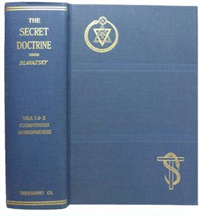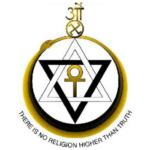The Writings of H.P. Blavatsky
We can do no better to describe the Writings of Blavatsky, than HPB herself. She devoted her life to putting forward once again the Wisdom Religion, so that we can discern what is true in all the world’s religions, sciences and philosophies contained within all the different forms.
THE TREE OF KNOWLEDGE
"No one can study ancient philosophies seriously without perceiving that the striking similitude of conception between all—in their exoteric form very often, in their hidden spirit invariably—is the result of no mere coincidence, but of a concurrent design; and that there was, during the youth of mankind, one language, one knowledge, one universal religion, when there were no churches, no creeds or sects, but when every man was a priest unto himself. And, if it is shown that already in those ages which are shut out from our sight by the exuberant growth of tradition, human religious thought developed in uniform sympathy in every portion of the globe; then, it becomes evident that, born under whatever latitude, in the cold North or the burning South, in the East or West, that thought was inspired by the same revelations, and man was nurtured under the protecting shadow of the same TREE OF KNOWLEDGE."
—H.P. Blavatsky, The Secret Doctrine, i, 341
Isis Unveiled
This book, totaling more than 1300 pages in two volumes, was the first to issue from the pen of H.P.B., published in 1877. Isis Unveiled unites a historical review of religious and scientific ideas with the spirit of the quest for truth. Of special interest to the West is the investigation of the origins of Christianity, including exhaustive study of the teachings of the gnostic sects of the first centuries, and an explanation of the mystery of Jesus. The first truly scientific account of the vast subject of "Magic" is offered in this work, which has for its sub-title: "A Master-Key to the Mysteries of Ancient and Modern Science and Theology."
Isis Unveiled is more than just a history, it is a study of our journey as, it is our very Self, that has incarnated into these many forms of life and ideas. What have we learned? How do we become more of who we truly are as spiritual, thought producing beings? What errors have we embodied along that journey and begin to create better pathways?
Photographic facsimile of the Original Edition, the two volumes bound in one.

The Secret Doctrine
In 1888, eleven years after the appearance of Isis Unveiled, H.P.B. completed and published The Secret Doctrine - The Synthesis of Science, Religion and Philosophy. The systematic character of this work is revealed by the subjects treated at length in its pages: Cosmogenesis, Cosmic Evolution, Anthropogenesis, the Evolution of Symbolism, the Archaic Symbolism of the World-Religions, Science and the Secret Doctrine Contrasted. The Secret Doctrine differs from Isis in that it deliberately unfolds a specific teaching about the nature of things. In the Introductory pages of Volume I, H.P. Blavatsky wrote: The Secret Doctrine is not a treatise, or a series of vague theories, but contains all that can be given out to the world in this century." The Secret Doctrine is, therefore, the basic source of the Theosophical teachings in this cycle.
Facsimile edition, two volumes in one.
The Secret Doctrine gives the complete journey of Evolution, taken by all Life. It leaves out no department of Nature and shows that Evolution is threefold, including soul, mind and body. It shows us that all real change and Evolution begins on the hidden side of nature and comes into visibility over a vast period of time called a Manvantara, then cycles back to a long rest called a Pralaya, before a new effort begins. All Life moves in Cycles, vast and small. “Life is not born nor dies, Life is invisible, yet in all things visible.”
A separate supplementary Index to The Secret Doctrine is also available; valuable to students, it contains many more entries than those in the original edition.

The Key to Theosophy
Designed by H.P.B. to afford a general perspective on the Theosophical teaching - and on the Theosophical Movement. In respect to the latter, the Key is an invaluable reference text (310 pages). The Key was published in 1889, to trace, as its author said, the broad outlines of the Wisdom Religion. This book is in the form of questions and answers. a dialogue between an Inquirer and a Theosophist explaining fundamental principles, and meeting, at the same time, the various objections raised by the average Western inquirer. Unfamiliar concepts are presented in clear language, and as simply as possible.
The Key to Theosophy helps students to unlock the doors of all ancient myths and cosmogonies. It shows how all our religious forms came from the same root cause. HPB gives us the keys to understand the esoteric side of all religions, and the means for which we can understand the laws governing man and the universe for ourselves.
The Key is especially valuable for its extended discussion of what happens after death and for the analysis of man's psychological nature.

The Theosophical Glossary
Theosophical books contain many unfamiliar conceptions, terms and allusions without adequate definition or explanation in available dictionaries and encyclopedias. The Theosophical Glossary, published in 1892, meets this need. The Glossary provides 389 pages of definitions and brief philosophical essays by H.P. Blavatsky on terms and subjects of the Theosophical teaching.
Facsimile of Original Edition.
The Theosophical Glossary helps all students understand the terms used to indicate the Wisdom Religion. English terms only, do not reflect the depth of meaning found in the ancient languages. An example is the word Manas or in English the Mind. Theosophy indicates that Manas or Mind is not a product of the brain, the physical existence, but is part of the cause of form. Manas or Intelligence comes before the form and is not a product of the form. Manas reflects a vast evolution. Not only is Mind in humankind, but it is reflected in all the forms of nature.
The Voice of the Silence
This rendition into English of selected passages from The Book of Golden Precepts� appeared in 1889, with the inscription by H.P.B., for the daily use of disciples. Of surpassing beauty in expression, it is a manual of devotion which thrills with the majestic purpose of the Saviors of mankind.
“Chafe not at Karma, nor at Nature’s changeless laws.
But struggle only with the personal, the transitory, the evanescent and the perishable.
Help Nature and work on with her; and Nature will regard thee as one of her creators and make obeisance.”
Transactions of The Blavatsky Lodge
In 1889, when H.P.B. was in London, the weekly meetings of the Blavatsky Lodge was devoted to the discussion of the archaic Stanzas� on which The Secret Doctrine is based. Transactions provides 150 pages of H.P.B.'s answers to metaphysical and scientific questions, as stenographically reported, and afterwards revised by her for publication. It also includes an extensive treatise on Dreams.
A Modern Panarion
This book was first published in 1895 by the Theosophical Society as a memorial of H.P.B.'s life and work. It offers articles she wrote before the Society was formed, which appeared in the press of that day, in spiritualistic journals, as well as many which were published in the early days of the Movement in various magazines, including the Theosophist. Students wishing to become better acquainted with the spirit of the opening years of the Theosophical Movement in the nineteenth century will appreciate this volume (504 pages).
Facsimile of Original Edition.

